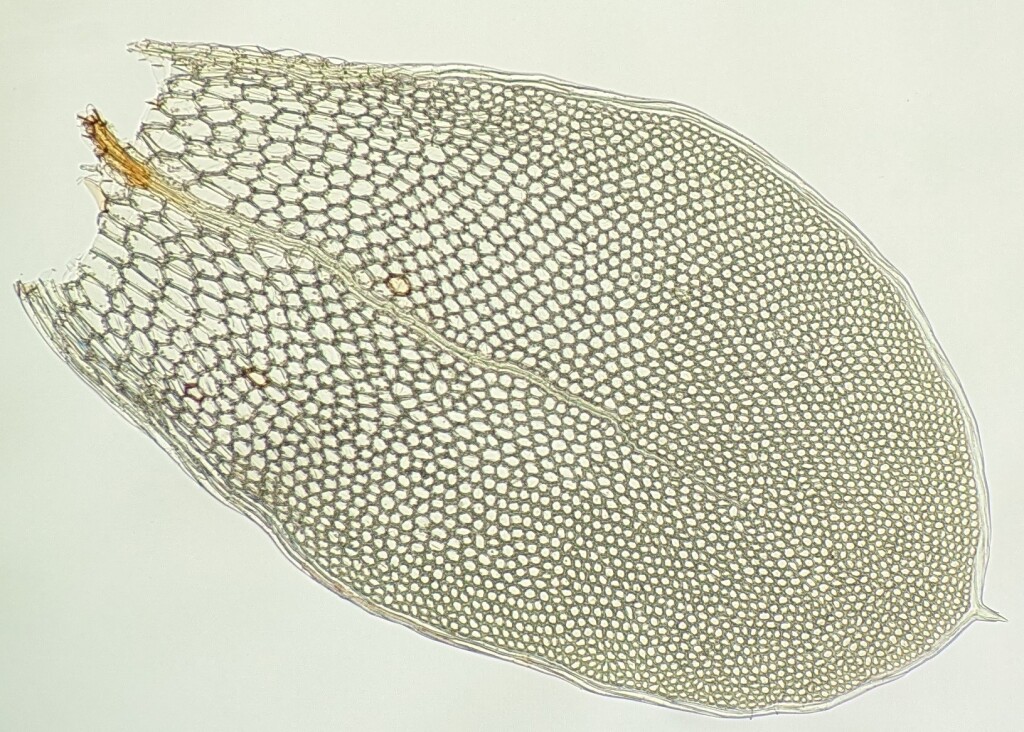Distichophyllum
Dioicous, autoicous (not in Victoria) or rarely synoicous (not in Victoria). Asexual reproduction by filamentous gemmae at leaf bases or by caducous leaves (not in Victoria). Mats on soil, rocks, logs, tree ferns and tree trunks, sometimes aquatic. Stems erect to creeping, sparingly branched, with sparse to dense (not in Victoria) rhizoids near base; central strand absent. Leaves ovate, oblong or elliptic to spathulate, mostly symmetric or sometimes asymmetric, in 6–8 ranks, complanate or erect-spreading in multiple directions when moist, scarcely altered to crisped or twisted when dry, those of ventral and dorsal ranks smaller than those of lateral ranks; apex rounded and cuspidate or acuminate (not in Victoria), without a hairpoint; costa single or spurred, extending to midleaf to 4/5 of leaf length; margin entire, crenate or denticulate, plane or reflexed, with or rarely without a border of more elongated cells; laminal cells hexagonal or rhombic, becoming longer and often rectangular toward base, occasionally enlarged and paler beside the costa in basal half of leaf, smooth. Seta smooth or papillose (not in Victoria). Capsules erect to pendent, straight, ovoid, obloid, cylindric or obovoid, without an annulus or annulus falling with the operculum. Calyptra mitrate, smooth, fimbriate at base or sometimes hairy throughout. Operculum rostrate. Peristome double; endostome segments as long as exostome teeth, with a high basal membrane; cilia rudimentary or absent.
Around 100 species shared between sub-Saharan Africa, Madagascar, the Mascarene Islands, South America, south-east Asia from Sri Lanka north to the Himalaya, China and Japan, east through Malesia and the Pacific Islands, and eastern Australia, but with a centre of diversity in Malesia; four species in Victoria.
Distichophyllum in its current circumscription encompasses a morphologically heterogenous assemblage of species and requires revision. This is exemplified by the Victorian species D. microcarpum (Hedw.) Mitt. that differs from all other Distichophyllum species by not having a distinct border of elongate cells. Elsewhere in the Daltoniaceae, presence or absence of leaf borders distinguish separate genera. Phylogenetic analyses of combined DNA sequences from all genomic compartments reiterates the status of Distichophyllum as a composite of many separate genera (Ho et al. 2012). Such phylogenies show that Distichophyllum in its current circumscription is composed of several separate lineages, many of which are more closely related to other genera than they are to each other. To revise Distichophyllum and restore its monophyly Ho et al. (2012) recommend the transfer of some of the Distichophyllum species to other currently recognised genera, including the transfer of two of the Victorian species, D. crispulum (Hook.f. & Wilson) Mitt. and D. rotundifolium (Hook.f. & Wilson) Müll.Hal. & Broth., to Leskeodon. The description of new genera will be necessary for other lineages, including a new monotypic genus for D. microcarpum and a new genus that will include D. pulchellum (Hampe) Mitt. Following this approach, a new monophyletic and more narrowly defined Distichophyllum will have no representatives in Victoria. However, descriptions and combinations outlined in these recommendations have not yet been published and await more thorough morphological revision of Distichophyllum. Until such revision takes place the Victorian species are tentatively retained in Distichophyllum.
 Spinning
SpinningHo, B.-C.; Pokorny, L.; Tan, B.C.; Frahm, J.-P.; Shaw, A.J.; Quandt, D. (2012). Molecular evolution and diversification of the moss family Daltoniaceae (Hookeriales, Bryophyta) with emphasis on the unravelling of the phylogeny of Distichophyllum and its allies. Botanical Journal of the Linnean Society 170: 157–175.



